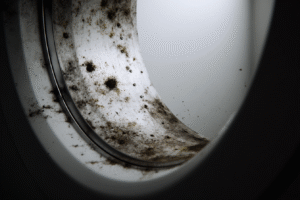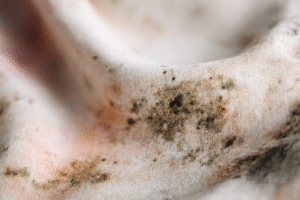Summarise this article with:
That musty smell wafting from your washing machine isn’t just unpleasant—it’s a sign that mould has made itself at home in your appliance. We understand how frustrating it can be when your freshly washed clothes come out smelling worse than when they went in. Black mould in washing machines is more common than you might think, particularly in the UK’s humid climate, and it can pose genuine health risks while potentially leading to costly repairs if left untreated.

What causes mould in washing machines?
Mould thrives in your washing machine when three key conditions come together: moisture, warmth, and organic matter. Front-loading machines are particularly vulnerable because their door seals trap water after each wash, creating the perfect breeding ground for those pesky spores.
When you close the door immediately after washing, you’re essentially creating a sealed, humid environment where mould can multiply faster than a TikTok dance trend. Low-temperature washes may save energy, but they don’t generate enough heat to kill existing mould spores.
The main culprits behind that funky smell include:
- Residual moisture from wet laundry left sitting too long
- Detergent residue building up in hidden corners
- Limescale deposits trapping moisture and providing a surface for mould to grow
To tackle black mould safely, start with the simplest fix – leave that door open after washing! Your machine needs to breathe too.
Spotting the signs: Is your washer harbouring mould?
Visual clues and musty smells
Your nose will often detect mould before your eyes do. That damp, musty smell hits you the moment you open your washing machine door – it’s unmistakable and frankly unpleasant. If your washing machine smells moldy, it’s trying to tell you something’s up!
Take a close look around the rubber door seal where you’ll spot dark spots or black patches lurking in the folds. The detergent drawer might reveal slimy residue or discoloration that shouldn’t be there.
If your freshly washed clothes carry that same musty odour, you’ve got your answer. Some people experience allergic reactions like sneezing or skin irritation when using a mould-infested machine – your body’s telling you there’s a problem that needs sorting.
Black spots on clothes and rubber seals
Those black spots appearing on your freshly washed clothes aren’t stains from the wash cycle – they’re mould fragments transferring from your machine’s rubber seals onto your garments. The rubber seal around your washing machine door becomes a prime target for visible mould because water gets trapped in its folds after each wash.
You’ll find these dark spots most commonly on the bottom section of the door gasket where gravity pulls moisture to settle. Grab a clean cloth and tackle this issue head-on – your favourite jumper will thank you!
Musty smells & mildew warning signs
That sulfur-like odor? It’s mildew saying “Hello, I’ve moved in!” Improper cleaning and using too much detergent create the perfect breeding ground. Check your detergent drawer for slimy buildup – it’s a mildew hotspot that’s easy to miss. Like we’ve been there before, these warning signs need addressing ASAP!
Is black mould in washing machines dangerous?
Health risks and respiratory concerns
Mould spores released from your washing machine can trigger respiratory problems including coughing, wheezing, and difficulty breathing. Studies show that individuals with asthma are up to 3 times more likely to experience flare-ups when exposed to black mould. People with existing lung conditions face heightened risks, as the presence of mould can worsen their symptoms significantly.
Allergic reactions are common when exposed to washing machine mould – expect sneezing, runny nose, and itchy eyes. Children, elderly family members, and anyone with compromised immune systems are particularly vulnerable to these effects.
The unpleasant odours aren’t just annoying; they indicate airborne spores circulating through your laundry area. Regular use of washing machine cleaner helps the decontamination process eliminate these health hazards before they become serious concerns.
Impact on your clothes and machine
Mould doesn’t just affect your health—it damages your washing machine too. Over time, black mould can corrode internal components, leading to drainage blockages and potential repair costs of hundreds of pounds. Your freshly washed clothes may develop stubborn stains and that persistent musty smell that no amount of fabric softener seems to fix. The machine’s efficiency also suffers, potentially increasing energy bills and shortening its lifespan.
How do you get rid of mould in a washing machine?
That musty smell from your washing machine? It’s not just a minor inconvenience—it’s mould having a party in your appliance! Let’s show that unwelcome guest the door with our step-by-step guide. Wecasa will be there for you, like we’ve been there before!
Safety first: gear up before you clean
Before diving into battle against the black mould, protect yourself properly. Mould spores can trigger respiratory issues and allergic reactions—no one wants to feel meh after cleaning day!
| PPE/Supply | Cleaning Agent | Quantity | Purpose |
|---|---|---|---|
| Rubber gloves | White vinegar | 1 cup | Disinfects and dissolves residue |
| Face mask | Bicarbonate of soda | ½ cup | Neutralizes odours, scrubbing agent |
| Safety goggles | Washing Machine Cleaner | As directed | Deep cleans internal components |
| Clean cloth | Hot water | As needed | Wiping and rinsing surfaces |
Step-by-step: remove mould from washer drum
Ready to kick that mould to the curb? Follow these easy steps:
Need more comprehensive instructions? Check out our washing machine cleaning guide for the full breakdown!
Regular maintenance is your BFF in preventing black mould from returning. Leave your washing machine door ajar after each use—mould hates fresh air as much as we hate cleaning the bathroom!
Cleaning the rubber seal and gasket
Removing black mould from door seals
That pesky black mould loves to hide in the folds of your washing machine’s rubber seal. The most stubborn spots usually lurk at the bottom of the seal where moisture gets trapped after each wash. For best results:
- Use a soft brush at a 45-degree angle to reach those tricky crevices
- Wipe thoroughly with a cloth soaked in equal parts solution
- Keep your door open after cleaning to let everything dry properly
Vinegar method vs bleach: which wins?
White vinegar is your washing machine’s best mate! Mix equal parts vinegar and warm water, then spray directly onto the mouldy areas. Let it sit for about an hour before wiping clean. Vinegar kills up to 82% of mould species and is safe for all washing machine types.
Bleach might seem stronger, but beware those fumes! While effective on non-porous surfaces, bleach doesn’t penetrate porous materials as well as vinegar does. Plus, vinegar leaves no harmful residue behind, making it the safer choice for your family and your machine.
Tackling the detergent drawer and dispenser
Deep cleaning stubborn mould buildup
That detergent drawer is the secret backstage area where all the washing magic happens! Start by pulling it completely out (check your manual if you’re feeling a bit lost in translation). Channel your inner Robbie Williams – let it soak, let it soak, let it soak! A warm bath of equal parts white vinegar and water will dissolve both limescale and mould in about 30 minutes. Grab an old toothbrush wrapped with a clean cloth for those hard-to-reach corners – like finding that last chocolate biscuit in the packet, you’ll want to get every bit!
Household remover products that work
For your detergent drawer’s stubborn spots, Astonish Mould & Mildew Spray and Dettol Antibacterial Mould Remover are your new BFFs. They’ll be there for you (when the rain starts to pour!). For a natural alternative, white vinegar works wonders – spray it directly, wait 10 minutes, then wipe away. Remember to leave your drawer slightly open after cleaning – like leaving the party door ajar, it lets fresh air circulate and prevents that unwelcome mould from making a comeback. Easy, peasy, lemon squeezy!
Drum cleaning and maintenance cycles
Run the Samsung washing machine cleaning cycle (or similar)
Running a regular cleaning cycle is essential for preventing mould buildup and removing limescale deposits. Your wet laundry shouldn’t be the only thing getting a proper wash! Here’s how to keep your drum spotless:
For best results, run this maintenance cycle monthly. Remember to leave the door open afterwards to allow proper air circulation and prevent that musty smell from returning.
Prevention: keeping your washing machine mould-free
Daily habits that make a difference
Looking to prevent that musty smell in your washing machine? A few simple daily habits can save you from a mouldy nightmare!
- Leave the door open after each wash cycle to allow air to circulate. This lets moisture escape rather than getting trapped in that perfect mould-breeding environment.
- Wipe the rubber seal with a clean cloth after your final wash of the day. Those folds in the door gasket are mould’s favourite hiding spot!
- Remove wet laundry promptly once the cycle finishes. Leaving damp clothes sitting in the machine creates extra humidity that mould absolutely loves.
Monthly maintenance routines
Even with daily care, your washing machine needs a monthly once-over to stay truly mould-free.
Run a hot wash cycle (60°C or higher) with no clothes at least once monthly to kill any lurking spores. Add white vinegar or a specialised washing machine cleaner to boost effectiveness.
Descaling is another essential task, especially in hard water areas. Limescale buildup doesn’t just affect performance—it creates rough surfaces where mould can attach and grow. Use a commercial descaler or vinegar solution in an empty hot cycle to tackle this issue.
If you do discover mouldy clothes, don’t panic! Learn how to wash mouldy clothes safely without spreading spores to other garments.
Why does my washing machine smell mouldy?
That musty, mouldy smell wafting from your washing machine isn’t just unpleasant—it’s your appliance crying out for help! Several culprits could be behind those funky smells: moisture trapped in the door seal, detergent residue buildup, or fabric softener creating a sticky film that mould loves to call home.
Quick deodorising fixes
Want to banish that smell ASAP? Try these fast fixes:
- Run a hot water cycle (60°C or higher) with nothing but the machine—heat kills mould spores
- Add a cup of soda crystals to your drum and run a hot cycle—they’re brilliant for dissolving soap scum
- Leave the door and detergent drawer open after every wash—proper ventilation is your best mate
When smell means hidden mould
If that funky odour persists despite your best efforts, you likely have hidden mould lurking in places you can’t see. Check behind the rubber seal where water collects, inside the detergent drawer housing, and in the filter. Black spots or slime are telltale signs you need more than a quick fix. Regular Maintenance is essential—that musty smell is often your first warning that mould is multiplying in your machine’s internal components.
When to call professional cleaning services
Sometimes, despite your best efforts, that stubborn mould just won’t budge. Don’t let it stress you out! Professional cleaning services can provide that deep clean your machine desperately needs.
Consider calling in the experts when:
- Black mould keeps returning despite multiple cleaning attempts
- You notice water leakage or unusual sounds during cycles
- Family members experience persistent allergic reactions
- You’re simply too busy juggling life’s demands (we totally get it!)
FAQ – Mould in Washing Machines
How do you clean the rubber seal on a washing machine?
+To tackle that rubber seal where black mould loves to hide, mix equal parts warm water and white vinegar in a spray bottle. Spray this solution generously on the seal, making sure it gets into all those tricky folds. Let it sit for about 15 minutes before wiping with a clean cloth. For stubborn spots, use an old toothbrush to gently scrub the crevices. Always dry the seal thoroughly after cleaning—moisture is mould’s best friend! This regular maintenance task should be done monthly to keep your washing machine in tip-top shape.
How do you remove black mould from a washing machine?
+Black mould doesn’t stand a chance when you bring out the big guns! Start by running a hot water cycle (60°C) with two cups of white vinegar in an empty machine. Next, create a paste with baking soda and water to scrub those visible mouldy patches on the rubber seal and detergent drawer. For persistent mould, a dedicated washing machine cleaner containing bleach can work wonders—just follow the product instructions carefully. Remember, never mix cleaning products as this can create harmful gases. Wipe everything dry when you’re done!
How do you clean mould from a washing machine using household products?
+Your kitchen cupboard holds powerful allies against mould! White vinegar is your star player—run a hot cycle with two cups of vinegar in the drum. Follow this with a baking soda cycle (half a cup in the drum) to neutralise odours and remove limescale buildup. For the detergent drawer, soak it in hot water with washing-up liquid, then scrub with an old toothbrush. Lemon juice works brilliantly too—it’s naturally antibacterial and leaves everything smelling fresh. These household heroes are often more effective than expensive commercial cleaners!
How do you get rid of a smelly washing machine?
+That damp, musty smell is telling you mould has moved in! First, run a hot cycle with two cups of white vinegar, followed by another with half a cup of baking soda to eliminate odours. Clean the rubber seal thoroughly, as trapped moisture there is often the culprit. Don’t forget to check and clean the drain filter where gunk can accumulate. Always leave the door and detergent drawer slightly open after washes to improve air circulation. For persistent smells, a washing machine cleaner specifically designed to combat odours can help break down the biofilm causing those nasty smells.
How do you prevent mould in a washing machine?
+Prevention is better than cure when it comes to washing machine mould! After each wash, leave the door and detergent drawer slightly ajar to allow air circulation. Wipe down the rubber seal regularly to remove moisture and residue. Run a monthly maintenance cycle with vinegar or a dedicated washing machine cleaner to prevent limescale and soap scum buildup. Use the correct amount of detergent—too much creates residue that feeds mould. Finally, run occasional hot washes (60°C or higher) to kill mould spores. These simple habits will keep your machine fresh and extend its lifespan!












